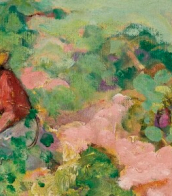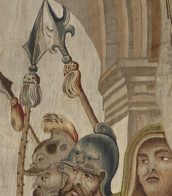muralism


Joseph Fernand Henri Léger was a French artist renowned for his innovative approach to Cubism and his transition towards a figurative, populist style. Born in Argentan, Orne, Lower Normandy, Léger's early career was marked by a stint as an architectural draftsman and a series of educational pursuits that eventually led him to Paris, where he embraced painting seriously. His artistic journey was significantly influenced by the bold abstractions of Cubism, characterized by geometric shapes and a vibrant palette, distinguishing his work from his contemporaries with what came to be known as "Tubism".
Léger's service in World War I profoundly impacted his artistic direction, leading him to adopt a 'mechanical' style that depicted the modern industrial world with sleek, tubular forms. This period saw creations like "Soldier with a Pipe" and "The Card Players," reflecting his war experiences and the mechanical aesthetics of the time. The post-war era encouraged Léger to explore the mechanical style further, evident in works like "The Bargeman" and "Mechanical Elements," highlighting the pace of technological advancement.
Throughout his career, Léger's work evolved, notably in the 1920s, where he aligned with Purist ideas, blending classicism with modernity. This phase is exemplified in "Woman with a Cat," showcasing a classical form with a modern, polished finish. By the 1930s, Léger's art took a more figurative, populist turn, aiming to democratize contemporary art and make it more accessible. His commitment to art education, especially for the common worker, underscored his belief in the social role of art.
For those intrigued by Joseph Fernand Henri Léger's groundbreaking contributions to modern art, his works can be found in prestigious museums worldwide. His legacy continues to inspire art collectors and enthusiasts alike. To stay updated on exhibitions and auction events featuring Léger's work, sign up for updates and embrace the unique opportunity to explore the richness of his artistic endeavors.

Joseph Fernand Henri Léger was a French artist renowned for his innovative approach to Cubism and his transition towards a figurative, populist style. Born in Argentan, Orne, Lower Normandy, Léger's early career was marked by a stint as an architectural draftsman and a series of educational pursuits that eventually led him to Paris, where he embraced painting seriously. His artistic journey was significantly influenced by the bold abstractions of Cubism, characterized by geometric shapes and a vibrant palette, distinguishing his work from his contemporaries with what came to be known as "Tubism".
Léger's service in World War I profoundly impacted his artistic direction, leading him to adopt a 'mechanical' style that depicted the modern industrial world with sleek, tubular forms. This period saw creations like "Soldier with a Pipe" and "The Card Players," reflecting his war experiences and the mechanical aesthetics of the time. The post-war era encouraged Léger to explore the mechanical style further, evident in works like "The Bargeman" and "Mechanical Elements," highlighting the pace of technological advancement.
Throughout his career, Léger's work evolved, notably in the 1920s, where he aligned with Purist ideas, blending classicism with modernity. This phase is exemplified in "Woman with a Cat," showcasing a classical form with a modern, polished finish. By the 1930s, Léger's art took a more figurative, populist turn, aiming to democratize contemporary art and make it more accessible. His commitment to art education, especially for the common worker, underscored his belief in the social role of art.
For those intrigued by Joseph Fernand Henri Léger's groundbreaking contributions to modern art, his works can be found in prestigious museums worldwide. His legacy continues to inspire art collectors and enthusiasts alike. To stay updated on exhibitions and auction events featuring Léger's work, sign up for updates and embrace the unique opportunity to explore the richness of his artistic endeavors.


Giovanni Battista Caracciolo, known as Battistello Caracciolo, was an early Baroque Italian painter.
Caracciolo was a follower of Caravaggio, a style that became the foundation for his work. He painted paintings and frescoes with scenes on religious themes.


Jacob Armstead Lawrence was a pioneering American artist, renowned for his dynamic cubism and profound portrayals of African-American life and history. Born in 1917 in Atlantic City, he moved to Harlem at a young age, where he was deeply influenced by the Harlem Renaissance. This vibrant cultural period helped shape his unique artistic style, which combined abstract expression with narrative elements.
Lawrence gained national recognition at just 23 years old with his 60-panel series "The Migration of the Negro" (later known as "The Migration Series"), which depicted the mass movement of African Americans from the rural South to the urban North. This work was first displayed at Edith Halpert's Downtown Gallery in 1941, making him the first African American artist to be represented by a mainstream New York gallery.
His art often depicted both historical and contemporary themes, making significant contributions to the representation of African American history in modern art. His works are housed in prestigious institutions such as the Museum of Modern Art (MoMA) and the Phillips Collection. In addition to painting, Lawrence also dedicated much of his life to teaching, influencing generations of artists at institutions like the University of Washington.
If you're keen to explore more about Jacob Lawrence's contributions to art and culture, consider subscribing for updates on exhibitions, sales, and auction events related to his work. This subscription will keep you informed about new discoveries and opportunities to engage with Lawrence's enduring legacy.









































































![[Jane Austen (1775-1817)]](/assets/image/picture_944583/2c259/12b35147a84a1317db475638d530110e1594292400jpg__fix_374_244.jpeg)
![[Jane Austen (1775-1817)]](https://veryimportantlot.com/assets/image/picture_944583/2c259/12b35147a84a1317db475638d530110e1594292400jpg__fix_374_244.jpeg)














